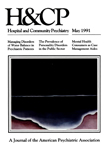Characteristics of Seriously Mentally Ill Adults in a Public Mental Health System
Abstract
To aid in planning mental health services, the state of Micbigan collected sociodemographic and clinical information on a sample of 2,447 mental health system clientele in both hospital and community settings. Hospitalized patients were found to have poorer functioning and higher levels of disability than cliets treated in community settings. Younger patients were more likely to be male, to exbibit more self-destructive bebaviors, and to be more aggressive and demoralized. Older patients were more likely to be women, to have a high degree of physical health care needs, and to possess poor skills in self-care and community living. The heterogeneous nature of the population and the presence of complicating problems not traditionally served by mental health systems, such as medical illness and substance abuse, point to a need for interagency planning to address the needs of seriously mentally ill adults.
Access content
To read the fulltext, please use one of the options below to sign in or purchase access.- Personal login
- Institutional Login
- Sign in via OpenAthens
- Register for access
-
Please login/register if you wish to pair your device and check access availability.
Not a subscriber?
PsychiatryOnline subscription options offer access to the DSM-5 library, books, journals, CME, and patient resources. This all-in-one virtual library provides psychiatrists and mental health professionals with key resources for diagnosis, treatment, research, and professional development.
Need more help? PsychiatryOnline Customer Service may be reached by emailing [email protected] or by calling 800-368-5777 (in the U.S.) or 703-907-7322 (outside the U.S.).



